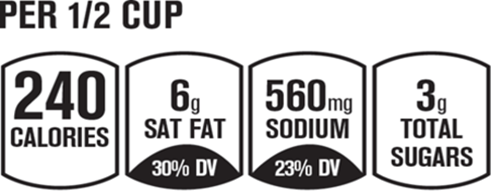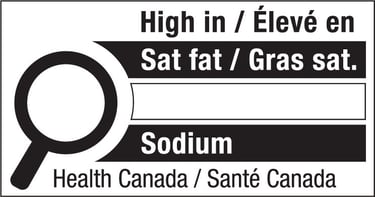 Consumers are accustomed to checking the Nutrition Facts panel on the back or side of a packaged food item for information about ingredients, allergens, and nutrition. In recent years, calls for food and allergen transparency and a greater focus on health have consumers paying even more attention to these labels and the ingredients listed on them. Recently, however, we’ve seen an increase in new regulations about what food and allergen labeling looks like and what information labels can (and can’t) include.
Consumers are accustomed to checking the Nutrition Facts panel on the back or side of a packaged food item for information about ingredients, allergens, and nutrition. In recent years, calls for food and allergen transparency and a greater focus on health have consumers paying even more attention to these labels and the ingredients listed on them. Recently, however, we’ve seen an increase in new regulations about what food and allergen labeling looks like and what information labels can (and can’t) include.
In some countries around the world, food manufacturers are required to publish front-of-package (FOP) labels to promote better consumer awareness and sway dietary choices. Usually, the regulations require a mandatory symbol, icon, or other visual cues on the front of food packaging that communicates healthy food choices and other critical ingredient information to consumers. But how do FOP labels help consumers and brands when the same information can be found on the Nutrition Facts panel? Let’s consider the various types of FOPs and their benefits.
FOP Labeling in North America
Neighboring countries like Mexico and Canada have both passed finalized regulations on the use of Front of Package (FOP) labeling, which is a major change for many food and beverage manufacturers. Canada’s regulation went into effect in 2022 with a compliance date of January 2026. Mexico, on the other hand, is currently rolling out updated nutrition labeling regulations in three implementation phases.
While the United States has yet to mandate FOP labeling on U.S. consumer goods, in January 2023, the FDA began to consider FOP regulations by issuing a Procedural Notice on Consumer Reports on FOP labeling and accepted public comments for 60 days following the publication of the notice. In the meantime, the U.S. allows voluntary FOP labeling options known as Facts Up Front or Nutrition Keys.
June 14, 2023 Update: The FDA released a second procedural notice on their intent to further research consumer responses to FOP labeling schemes. The study, titled “Quantitative Research on Front of Package Labeling on Packaged Foods,” is a follow up to the previous notice and studies that used focus groups to explore the benefits of FOP labeling. The procedural notice also opened a public comment period from June 15 – July 17, 2023. Additionally, the Food Labeling Modernization Act of 2023 also introduces a new FOP program, but the bill has yet to pass Congress and become law.

The Facts up Front FOP was developed in 2011 to provide consumers with quick and easy-to-understand information about the nutritional content of packaged foods.
Under the program, food manufacturers can display calories, saturated fat, sodium, and sugar content to allow consumers to easily compare nutritional value across various products. While voluntary, many food manufacturers use the label on their products.
FOP Labeling Benefits: Awareness, Transparency, and Healthy Habits
FOP labeling is gaining traction in different countries as a way to communicate food choices to consumers in an easy-to-understand manner. As researchers in these countries investigate the impact of FOP labeling, they have identified a few key benefits for consumers and food manufacturers.
Improved Consumer Awareness Through Standardization
Placing labels on the front of packages can help consumers quickly identify healthier food options. In Canada, for example, FOP labels will show a magnifying glass to help shoppers easily recognize products that are high in sodium, sugar, or saturated fats. Mexico and Chile similarly use octagonal warning signs, and the UK uses a voluntary “traffic light” system (under certain conditions) to identify items with high, medium, or low amounts of specific nutrients.
FOP Examples Around the World

The new Canadian FOP label shows a black and white magnifying glass next to test that reads: High in/Eleve en | Sat far / Gras sat |(blank space for sugar if the product qualifies) | Sodium | Health Canada / Sante Canada.

An example of Mexico's FOP octagonal FOP signs. English translation in the order above: excess calories, excess sugar, excess saturated fat, excess trans fat, and excess sodium.

An example of the UK "Traffic Light" FOP symbols used in food packaging.
The uniformity of the symbols used allows shoppers to instantly recognize healthier food options when browsing store shelves, regardless of store or brand. In turn, standardization helps build trust in new labeling faster and creates an easily learnable system for consumers.
Increased Nutrition Transparency
FOP labeling can provide consumers with clear and concise information about the nutritional content of food products. By displaying key information such as calories, saturated fat, sodium, and sugar content on the front of the package, FOP labeling allows consumers to quickly compare products and make informed decisions about what they eat.
Research studying the merits of FOP labels have found these tools can provide quick information on nutrients, a host of summary statistics on consumer behavior, and enable better food group categorization.
As food and allergen labeling regulations continue to evolve in the U.S., companies in the food industry will face increasing accountability for providing consumers with accurate and non-misleading information, even without mandated FOP labels. In addition, consumers are showing a growing preference for food manufacturers that are transparent about their ingredients, nutrients, and company policies.
Encouraging Healthy Eating Habits
FOP labeling can promote healthier food choices by highlighting nutrient-dense foods and encouraging consumers to consider the nutritional quality of their food purchases.
Following the implementation of mandatory FOP labeling in Chile in 2016, researchers have discovered a significant reduction in total sugars, saturated fats, and sodium in youth diets. Researchers believe FOP labeling, along with other mandatory changes implemented by the law, contributed to these dietary changes.
While more research is needed to understand the full and continued impact in Chile, Mexico and Canada have used these positive results to influence their FOP labeling laws. The U.S. may be next.
Considerations for Manufacturers Before Using FOP Labels
While there are a number of benefits to FOP labeling, there are also some impacts that food manufacturers will need to consider. While the U.S. has yet to implement mandatory FOP labeling, manufacturers should keep these considerations in mind in case future regulatory changes happen.
Limited Scope and Impact
FOP labeling may only provide a limited snapshot of a food product’s nutritional value. Many consumers already neglect to read the nutritional labels that are on the back or side of packaging and may now assume that it’s not necessary because they have a quick summary right on the front of their product. Consequently, shoppers may not understand the full nutritional complexity of the food but incorrectly believe they do.
Simply including FOP labeling may not be enough to effectively promote healthier food choices if consumers do not understand or use the labels. Consequently, regulatory agencies like the FDA or the companies themselves may be forced to spend money on marketing and educational campaigns. Even then, it’s not possible to know whether there will be widespread adoption of the labels or if they’ll be effective in the U.S. without trial (and perhaps error).
Increased Cost and Compliance Risks
Nothing is done for free, and FOP labeling is certainly the same. It can be costly for food manufacturers to design and implement new packaging across their product lines. It may also force companies to use more materials like cardboard, plastics, and ink if the packaging becomes larger. These costs may then be passed on to consumers in the form of higher store prices.
Additionally, companies will have to maintain compliance with any new regulations on FOP labeling in the U.S. As with any regulation change, companies can risk non-compliance if they don’t fully understand the regulation. And while the FDA often provides ample time to understand and implement changes, they are less forgiving of mistakes after the compliance date arrives. Companies that misuse FOP labels, mislabel products, or don’t follow compliance requirements could face an FDA Warning Letter or costly product recall.
Other Packaging Symbols
Manufacturers may notice other types of symbols or labels on the front of a product’s package that are different from FOP labels, but have a similar intention to drive consumer awareness. Here are the difference between these various packaging claims:
- FOP labeling is a standardized system that typically displays key nutrient information in a simple format for consumers to assess the nutritional value of products.
- Nutrient content claims are statements about the amount of a specific nutrient in a food product. Some examples include “low-fat” or “a good source of vitamin C.” These claims are regulated by the FDA and can appear anywhere on the food or dietary supplement package.
- Packaging claims are statements about the characteristics of a food product, such as the production method, ingredients, or health benefits. Some of these claims are regulated by the FDA, while others may be implemented by state groups or other organizations. Some examples include USDA Organic labels (regulated by the USDA), California Prop 65 labels (regulated by California code), and the term “healthy” (which will likely see qualification changes from the FDA soon).
Invest in Tools to Help with FOP Labeling
Ultimately, FOP labeling can be a useful tool for promoting healthier food choices and increasing transparency in the food industry, keeping consumers safe and protecting brands and companies from a non-compliance headache. It’s important, however, that governments or health agencies carefully regulate FOP labeling to prevent misleading labeling practices and ensure that consumers have access to accurate and comprehensive nutritional information. And soon, the U.S. could see regulation changes around FOP labeling requirements.
Whatever type of labeling your food or beverage products require, a solution like Trustwell’s Genesis Foods Formulation & Labeling Software can help companies ensure product transparency and regulatory compliance. If you are interested in learning more, connect with our team at Trustwell today.
Other posts you might be interested in
View All Posts
Food Labeling
6 min read
| August 10, 2023
What is the Food Labeling Modernization Act, and How Will it Impact Food Labels?
Read More
Supplier Compliance
5 min read
| August 3, 2018
Food Safety Challenges of Convenience Foods
Read More
Food Industry
6 min read
| October 18, 2019

